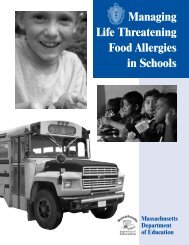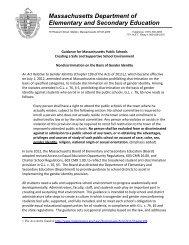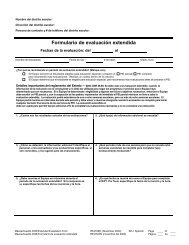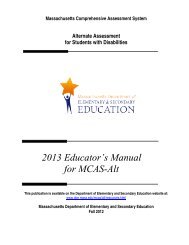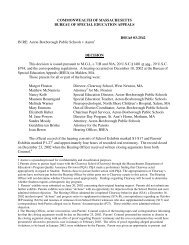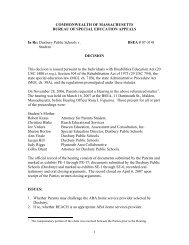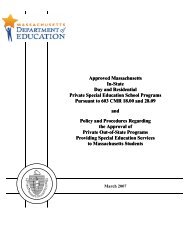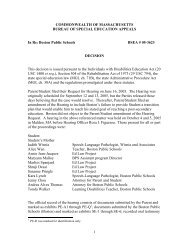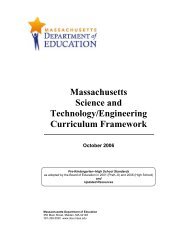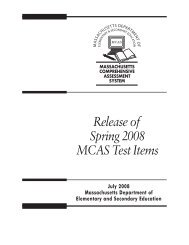Two Year Follow-up Review for Matthew J. Kuss Middle School
Two Year Follow-up Review for Matthew J. Kuss Middle School
Two Year Follow-up Review for Matthew J. Kuss Middle School
Create successful ePaper yourself
Turn your PDF publications into a flip-book with our unique Google optimized e-Paper software.
<strong>Follow</strong>-<strong>up</strong> <strong>Review</strong> Report, Spring 03 <strong>Kuss</strong> <strong>Middle</strong> <strong>School</strong>, Fall River, MA page 2<br />
discussion and observation, based on the evidence available to it. A list of Panel members who<br />
participated in the review is provided in Appendix A. A detailed schedule of the Panel's<br />
activities is provided in Appendix B.<br />
The Panel's findings and conclusions on the five key questions will be <strong>for</strong>warded to the<br />
Commissioner of Education <strong>for</strong> consideration, together with the school’s status reports and<br />
student per<strong>for</strong>mance data, in determining whether <strong>Kuss</strong> <strong>Middle</strong> <strong>School</strong> is deemed to be<br />
chronically under-per<strong>for</strong>ming. The Panel was not asked to <strong>for</strong>mulate a sound plan <strong>for</strong> school<br />
improvement where such a plan does not presently exist or to recommend a course of action to<br />
create the conditions <strong>for</strong> successful implementation of sound improvement strategies where such<br />
conditions at present do not appear to exist.<br />
Executive Summary<br />
Students at the <strong>Matthew</strong> J. <strong>Kuss</strong> <strong>Middle</strong> <strong>School</strong> have demonstrated some progress toward<br />
proficiency in expected knowledge and skills since the school’s designation as under-per<strong>for</strong>ming<br />
in 2001. <strong>School</strong> staff and administrators have made significant progress implementing the<br />
programs and practices listed in the <strong>School</strong> Improvement Plan approved by the Board of<br />
Education. The improvement initiatives with the greatest impact on the school’s per<strong>for</strong>mance<br />
include redesign of the daily schedule to provide common planning time <strong>for</strong> teachers, provision<br />
of professional development s<strong>up</strong>port during the school day as well as in s<strong>up</strong>plementary released<br />
days, regular ongoing s<strong>up</strong>port <strong>for</strong> professional growth guided by Turning Points facilitators, and<br />
a positive professional climate reflected in widespread s<strong>up</strong>port <strong>for</strong> improvement ef<strong>for</strong>ts. Factors<br />
influencing the relatively slow pace of improvement in student per<strong>for</strong>mance include serious<br />
shortfalls in the 2002 district budget leading to high staff turnover, the purposeful incremental<br />
adoption of the mathematics program, and insufficient oversight of instructional change.<br />
The school’s ef<strong>for</strong>ts to continue its improvement work include participation of a representative<br />
team in the Per<strong>for</strong>mance Improvement Mapping (PIM) activities and the development of a 2003-<br />
04 improvement plan. Early drafts of the PIM plan indicate significant growth in the school’s<br />
sophistication in using per<strong>for</strong>mance data to guide selection of strategies likely to lead to gains in<br />
student learning. Systematic strategies to monitor the quality of implementation of its initiatives<br />
as well as methods to assess the impact of new programs and practices on student achievement<br />
are absent from the PIM draft, replicating a weakness in the original SIP.<br />
The school’s ability to sustain its ef<strong>for</strong>ts toward improvement depend on continuing district<br />
s<strong>up</strong>port <strong>for</strong> professional development time and consultant services, staff and administrator<br />
stability, and maintenance of the positive professional climate at the school. Challenges to the<br />
school’s ability to continue its progress include inadequate communication with all stakeholder<br />
gro<strong>up</strong>s, and insufficient oversight of the quality of program implementation and regular<br />
assessment of their impact on students.<br />
<strong>Follow</strong>ing are the findings from each of the five key questions:<br />
Massachusetts Department of Education



